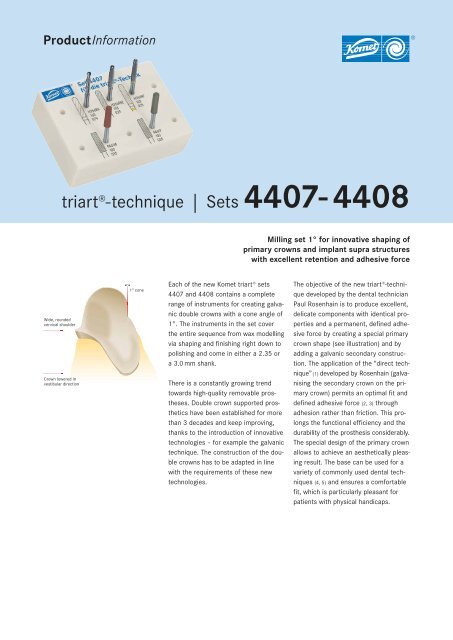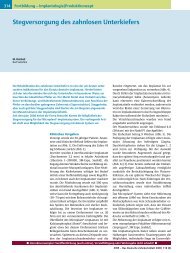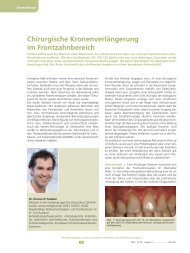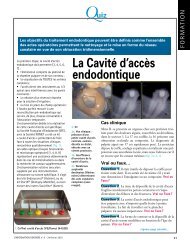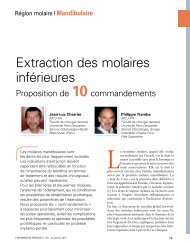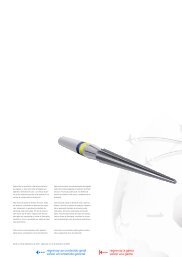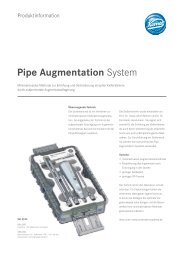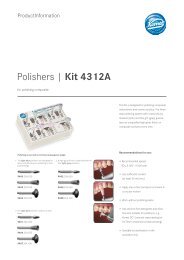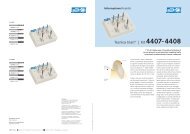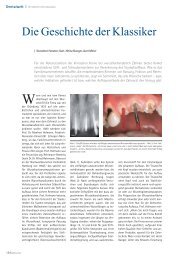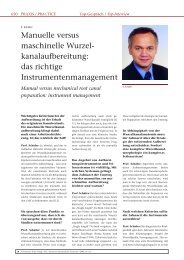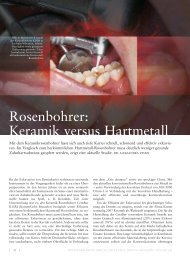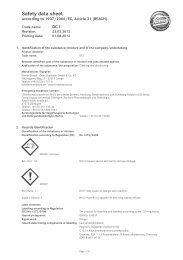triart®-technique | Sets 4407- 4408 - Kometdental.de
triart®-technique | Sets 4407- 4408 - Kometdental.de
triart®-technique | Sets 4407- 4408 - Kometdental.de
You also want an ePaper? Increase the reach of your titles
YUMPU automatically turns print PDFs into web optimized ePapers that Google loves.
ProductInformation<br />
Wi<strong>de</strong>, roun<strong>de</strong>d<br />
cervical shoul<strong>de</strong>r<br />
Crown lowered in<br />
vestibular direction<br />
triart ® -<strong>technique</strong> | <strong>Sets</strong> <strong>4407</strong>- <strong>4408</strong><br />
1° cone<br />
Each of the new Komet triart ® sets<br />
<strong>4407</strong> and <strong>4408</strong> contains a complete<br />
range of instruments for creating galvanic<br />
double crowns with a cone angle of<br />
1°. The instruments in the set cover<br />
the entire sequence from wax mo<strong>de</strong>lling<br />
via shaping and finishing right down to<br />
polishing and come in either a 2.35 or<br />
a 3.0 mm shank.<br />
There is a constantly growing trend<br />
towards high-quality removable prostheses.<br />
Double crown supported prosthetics<br />
have been established for more<br />
than 3 <strong>de</strong>ca<strong>de</strong>s and keep improving,<br />
thanks to the introduction of innovative<br />
technologies – for example the galvanic<br />
<strong>technique</strong>. The construction of the double<br />
crowns has to be adapted in line<br />
with the requirements of these new<br />
technologies.<br />
Milling set 1° for innovative shaping of<br />
primary crowns and implant supra structures<br />
with excellent retention and adhesive force<br />
The objective of the new triart ® -<strong>technique</strong><br />
<strong>de</strong>veloped by the <strong>de</strong>ntal technician<br />
Paul Rosenhain is to produce excellent,<br />
<strong>de</strong>licate components with i<strong>de</strong>ntical properties<br />
and a permanent, <strong>de</strong>fined adhesive<br />
force by creating a special primary<br />
crown shape (see illustration) and by<br />
adding a galvanic secondary construction.<br />
The application of the “direct <strong>technique</strong>”<br />
(1) <strong>de</strong>veloped by Rosenhain (galvanising<br />
the secondary crown on the primary<br />
crown) permits an optimal fit and<br />
<strong>de</strong>fined adhesive force (2, 3) through<br />
adhesion rather than friction. This prolongs<br />
the functional efficiency and the<br />
durability of the prosthesis consi<strong>de</strong>rably.<br />
The special <strong>de</strong>sign of the primary crown<br />
allows to achieve an aesthetically pleasing<br />
result. The base can be used for a<br />
variety of commonly used <strong>de</strong>ntal <strong>technique</strong>s<br />
(4, 5) and ensures a comfortable<br />
fit, which is particularly pleasant for<br />
patients with physical handicaps.
The right tool leads to success<br />
1° Wax cutter, shaping and finishing<br />
instruments H356RA, H356RSE and<br />
H356RF. The minimum cone angle of<br />
1° solves the problem of the <strong>de</strong>creasing<br />
adhesive force of conventional double<br />
crowns caused by an increasing<br />
cone angle. Contrary to telescopic double<br />
crowns, the prosthesis cannot jam<br />
during insertion and removal, which<br />
would cause severe problems to el<strong>de</strong>rly<br />
and physically handicapped patients.<br />
The conveniently large radius at the tip<br />
of the 1° Komet instruments for the<br />
triart ® -<strong>technique</strong> permits the creation<br />
of excellent shoul<strong>de</strong>rs. They create<br />
sufficient space for the individual components<br />
of the galvanic secondary and<br />
tertiary constructions, which is the precondition<br />
for <strong>de</strong>licate, natural looking<br />
teeth. Even in case of shorter abutment<br />
teeth, the creation of a roun<strong>de</strong>d cervical<br />
shoul<strong>de</strong>r (chamfer) helps to provi<strong>de</strong> a<br />
sufficiently large surface to ensure<br />
optimum adhesive force.<br />
The smooth, low-vibrating operation<br />
and the effective substance removal<br />
allow controlled, yet time-saving work<br />
and the creation of beautifully smooth<br />
surfaces. The final scaling of the wax<br />
surfaces – once a common procedure<br />
– can now be omitted, and the cast<br />
work pieces are optimally prepared to<br />
polishing stage with the help of the<br />
congruent Komet cutters. The laser<br />
marking on the shank indicating the<br />
<strong>de</strong>gree of the cone angle allows quick<br />
recognition of the appropriate 1° cutter.<br />
1<br />
2<br />
3<br />
H356RA.103.029<br />
H356RSE.103.029<br />
H356RF.103.029<br />
Recommendations for use<br />
The cutters are exclusively used in<br />
the milling <strong>de</strong>vice.<br />
1. Work on wax is to be carried out<br />
with instrument H356RA and Waxit, at<br />
a speed of 3 000 rpm (clockwise<br />
rotation)<br />
2. Instrument H356SE is recommen<strong>de</strong>d<br />
for shaping, at a speed of<br />
10 000 rpm (counter rotation),<br />
using milling oil and wax<br />
3. Optimal surfaces are created<br />
when instrument H356RF is used for<br />
finishing at a speed of 3 000 rpm<br />
(counter rotation), using milling oil<br />
and wax.
The new Komet polishing<br />
system for the milling <strong>technique</strong><br />
1° polishers 9441M and 9441F are<br />
used for polishing and high-shine<br />
polishing. The innovative, time-saving<br />
Komet polishing system is <strong>de</strong>signed<br />
for use in the milling <strong>de</strong>vice. Its special<br />
construction allows to achieve surfaces<br />
of outstanding precision.<br />
Thanks to their small diameter, these<br />
polishers can get into hard-to-reach<br />
areas such as lowered, cervical shoul<strong>de</strong>rs<br />
without time-consuming dressing.<br />
Mirror-like surfaces are created without<br />
effort.<br />
The special polishing material adapts<br />
optimally to roun<strong>de</strong>d shoul<strong>de</strong>rs, whereas<br />
the carrier in the core ensures axial<br />
stability.<br />
4<br />
5<br />
9441M.103.035<br />
9441F.103.035<br />
Application<br />
The polishers are used in the milling<br />
<strong>de</strong>vice only, applying low contact<br />
pressure.<br />
4. The polisher 9441M is to be<br />
used for dry polishing, at a speed<br />
of 6 000 rpm.<br />
5. High-shine polishing is done with<br />
polisher 9441F, again dry and at a<br />
speed of 6 000 rpm.
Set <strong>4407</strong><br />
H356RA.103.029<br />
H356RSE.103.029<br />
H356RF.103.029<br />
9441M.103.035<br />
9441F.103.035<br />
Set <strong>4408</strong><br />
H356RA.123.029<br />
H356RSE.123.029<br />
H356RF.123.029<br />
9441M.123.035<br />
9441F.123.035<br />
Literature:<br />
(1) Rosenhain P.: Die Herstellung <strong>de</strong>r Primärund<br />
Sekundärteile auf galvanischem Weg.<br />
Vi<strong>de</strong>o A-G-C System: Impressionen;<br />
Wieland Pforzheim 1990<br />
(2) Bongartz B., Faber F.-J., Kerschbaum T.:<br />
Evaluation of removable bridges with electoformed<br />
402711V0 ·<br />
telescopic retainers, Kongress <strong>de</strong>r <strong>de</strong>utschen<br />
Gesellschaft für Zahn-, Mund- und Kieferheilkun<strong>de</strong>;<br />
HB/1 ·<br />
Hannover 2002<br />
(3) Diese steht in Abhängigkeit zur Kronenanzahl<br />
(Minimum vier Zähne), vgl. Faber F.-J. , Huber C.:<br />
Germany in<br />
Ursache und Begrenzung <strong>de</strong>r Haftkraft bei<br />
Galvano- Teleskopkronen; Universität zu Köln 2003<br />
Printed ·<br />
(4) Diedrichs G., Rosenhain P.: Bio-Ästhitik in<br />
<strong>de</strong>r restaurativen Zahnheilkun<strong>de</strong>. Neuer Merkur;<br />
Technical advisor:<br />
München 1995<br />
Germany ·<br />
Paul Rosenhain<br />
(5) Hahn, L., Weigel, P., Lauer, H-CH., Hamacher, O.:<br />
In vitromo<strong>de</strong>ll for the wear of tape crown sytems.<br />
Address correspon<strong>de</strong>nce to:<br />
30. Jahrestagung <strong>de</strong>r Arbeitsgemeinschaft für<br />
<strong>de</strong>paro@t-online.<strong>de</strong><br />
Grundlagenforschung in <strong>de</strong>r DGZMK; Mainz. T15 1998<br />
BRASSELER GEBR. · 03/2005<br />
GEBR. BRASSELER GmbH & Co.KG · Postfach 160 · 32631 Lemgo · Germany · Telefon: +49 (0) 5261 701-0 · Telefax: +49 (0) 5261 701-289 · info@brasseler.<strong>de</strong> · www.brasseler.<strong>de</strong> ©


